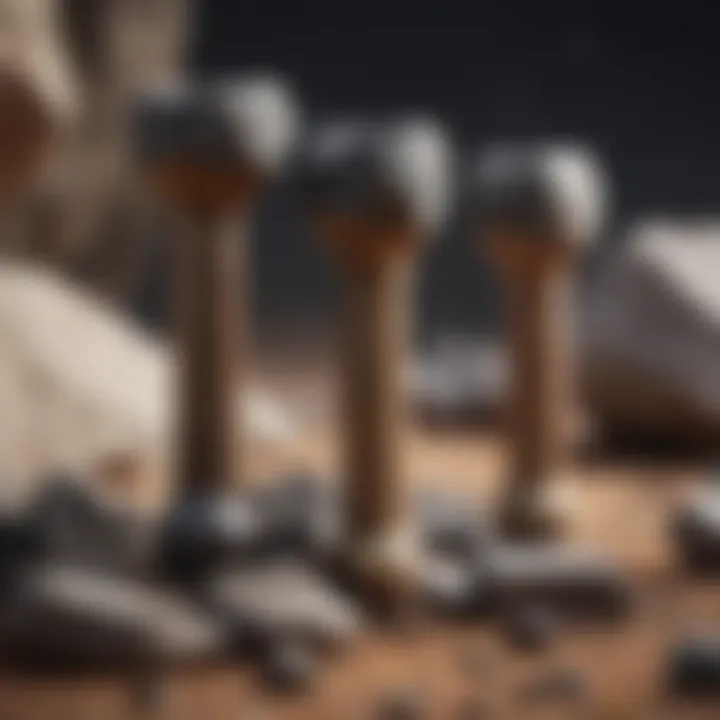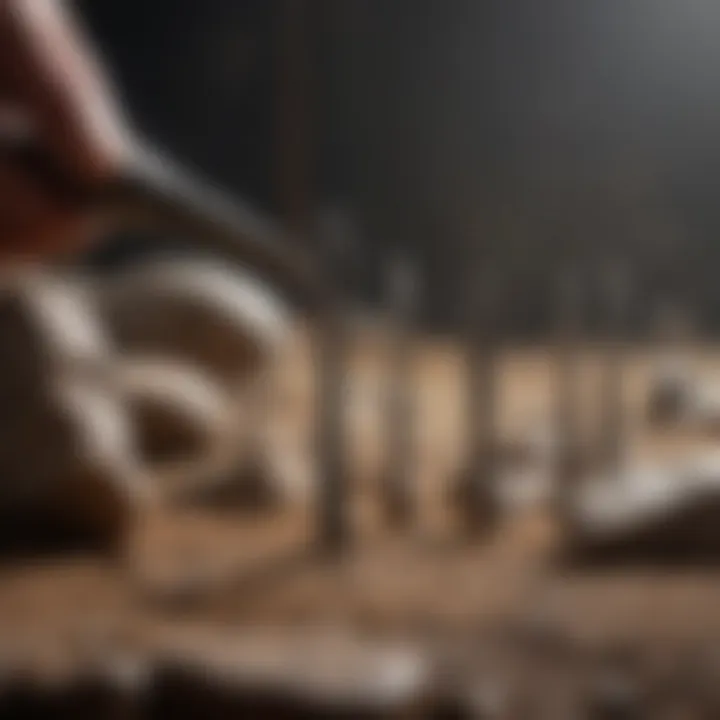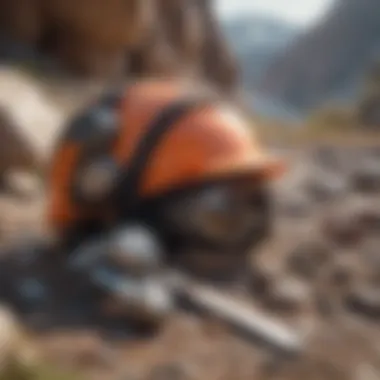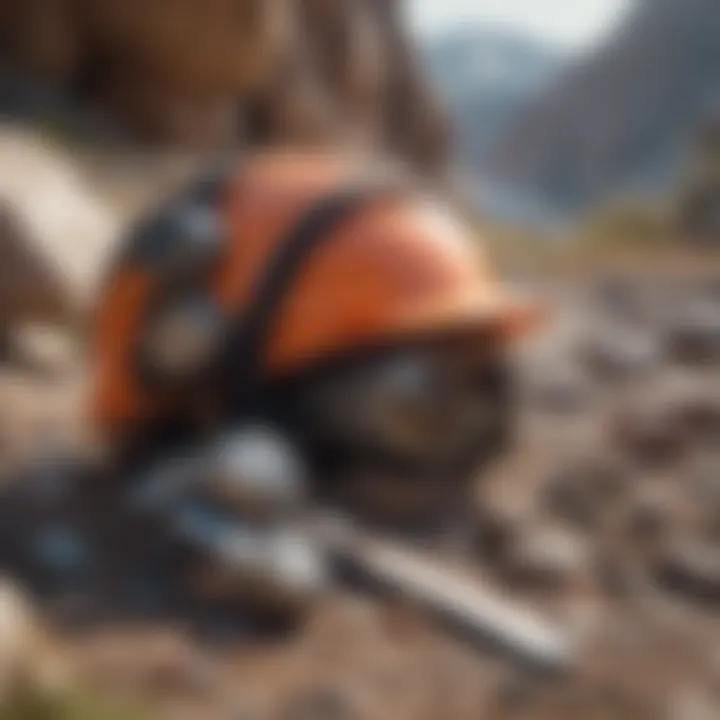Exploring Essential Tools for Rock and Fossil Study


Intro
When it comes to geology and paleontology, understanding the tools of the trade can significantly enhance both the collecting experience and the scientific value of findings. Every collector, from amateur rock hounds to seasoned scientists, can benefit from being well-versed in the tools that facilitate exploration, identification, and preservation of rocks and fossils. This article seeks to illuminate the various rock tools and equipment essential for such endeavors, providing insights into their functions, types, and applications.
The world of rock collecting isn’t just about luck; it’s about having the right gear in your arsenal. From the small hand pick that helps dislodge fossils to advanced digital imaging devices that capture intricate details, rock tools are varied and serve different specific purposes. Knowing which tool to deploy in a given situation can mean the difference between a successful venture and a rather tiresome day.
Moreover, as technology advances, so do the methodologies of geology. Modern innovations are redefining how collectors and professionals alike approach their craft. Yet, amidst all these advancements, the importance of traditional instruments remains ever relevant, retaining an essential role in geological education and practice. This article will unpack these traditions, explain modern improvements, and highlight critical safety measures—ensuring that every trip into the field is productive and, most importantly, safe.
In what follows, we will delve into specific tools, exploring each item's historical significance and current applications while also offering identification techniques that enhance any collector’s skills. Let’s kick off our journey with an exploration of this month’s featured collectible.
Prolusion to Rock Tools and Equipment
In the realm of geology, the tools and equipment we use play an essential role in shaping our understanding of mineral and fossil deposits. For both hobbyists and professionals alike, having the right instruments at hand not only makes the process of exploration and analysis more efficient, it also allows for a deeper appreciation of the natural world. This article dives into various tools, from basic hand tools to advanced analytical devices, highlighting their core functions and the benefits they provide.
"The right tool for the job can make all the difference; it’s not just about digging deeper but understanding what you uncover."
The Relevance of Tools in Geology
Tools are not merely accessories; they are critical components in unpaid geology experiments. From the simplest hammer to sophisticated X-ray spectrometers, each tool serves a unique purpose that aids in the collection and analysis of geological samples. For instance, a geological pick is designed specifically for breaking tough rock, as opposed to a standard hammer, which may not be effective against dense formations. Without the right tools, one can miss out on significant findings, whether it be a unique mineral composition or an exceptional fossil. Therefore, their importance cannot be overstated.
Additionally, tools often define the boundaries of exploration. When collectors venture into remote locations, certain equipment becomes indispensable, not only for research but also for safety. Understanding their relevance helps collectors navigate their geological adventures more effectively, enabling smarter, more purposeful explorations.
An Overview of Equipment Types
Tools in geology are as varied as the rocks themselves. They can be broadly categorized into two main types: hand tools and field equipment.
- Hand tools are the everyday essentials for rock and fossil collectors. This category includes hammers, chisels, hand lenses, and field notebooks, all designed for immediate tasks and use in the field. The design and material of these tools directly correlate with their effectiveness in rock collection, making it vital to select appropriate models.
- On the other hand, field equipment is typically more sophisticated and often includes instruments like GPS devices and surveying tools. These devices help geologists map locations accurately and obtain precise data regarding sample sites. These two categories together provide the framework for a comprehensive toolkit geared towards geological exploration.
Basic Hand Tools for Rock Collection
When it comes to the art of rock collecting, the journey often begins with basic hand tools. These instruments are not just a luxury; they are essential for anyone serious about pebble-hunting, geology, or the study of paleontology. Basic hand tools provide the foundation for exploring, identifying, and collecting rocks. Without them, the art and science of rock collecting would stand on shaky ground.
The beauty of these tools is their versatility, catering to both novices and seasoned collectors. They allow enthusiasts to gain hands-on experience in the field, making the overall process more rewarding. Understanding how to use each tool thoughtfully and skillfully can foster a deeper connection with geology and a more meaningful gathering experience.
Hammers and Chisels
Hammers and chisels are perhaps the backbone of any rock collector's toolkit. The right hammer can make all the difference, not only in collecting but also in ensuring safety while working with geological materials.
A geologist's hammer, specifically designed for this purpose, often features a flat striking surface on one end and a sharp point on the other. This dual functionality allows for effective splitting of rocks and tapping away at stubborn materials. It's akin to having a trusted companion that can help you navigate through tough surfaces.
When choosing a hammer, weight and balance are key factors. A hammer that's too heavy can lead to fatigue, while one that’s too light may not do the job right. A weight range of about 1 to 2.5 pounds generally works well for most collectors. As for chisels, they help in detailed work. Investing in good-quality chisels ensures that you can cleanly break rocks or fossils without causing unnecessary damage.
Hand Lens
Hand lenses might seem small and unassuming, but they are invaluable tools for any serious collector. These magnifying devices allow for a closer look at rock textures, mineral compositions, and even potential fossil remnants. Understanding these details can differentiate a simple rock from a valuable specimen.
When out in the field or perusing your latest find at home, a good hand lens enhances your ability to spot unique characteristics that are not easily visible to the naked eye. You might overlook a shimmering quartz vein or intricate striation patterns, which could be a game-changer for your collection.
Look for a hand lens with at least 10x magnification, as this level can help reveal necessary details, yet is still manageable for handheld use. Some come with built-in LED lights, making nighttime or dim conditions far easier to work in.
Field Notebooks
Finally, field notebooks serve as the unsung heroes of rock collection. Whether you're jotting down GPS coordinates, sketching rock formations, or keeping track of weather conditions, these humble documents play a critical role.


A field notebook is not just a simple log; it can become a treasure trove of information over time. Writing down observations helps solidify your understanding of geological processes. You might find later that your notes come in handy for future reference or for validation at a geology club or symposium.
Choose a notebook that can withstand the rigors of fieldwork. Water-resistant paper is a plus. Loom not only at the lines on the page, but also consider using different colors of ink to categorize entries by different trips, or types of rock and fossil finds. This approach could make your notes more visually engaging and easier to reference later.
"Collecting is not merely about gathering; it’s about understanding, learning, and creating a dialogue with nature."
Advanced Tools in Rock Analysis
Understanding advanced tools in rock analysis is crucial for any geologist or paleontologist aiming to deepen their research and findings. These tools significantly enhance our ability to observe and understand the nature of rocks, minerals, and fossils on a microscopic level. In today’s fast-paced world, precision and accuracy are non-negotiable when it comes to carrying out geologic analyses. Thus, having access to advanced tools offers several benefits—enhancing data collection, improving communication of results, and ultimately facilitating better decision-making.
Geological Picks
Geological picks are versatile tools, playing a critical role in both fieldwork and laboratory settings. They come with a pointed tip and a broader face, which allows for both chiseling and prying. Geologists often rely on the ergonomic design of picks for accuracy when extracting samples from outcrops or sediment layers without damaging the specimen.
When selecting a geological pick, consider the weight and comfort, as this tool is often used for long periods. Understanding the different styles available—like a rock pick or a chisel pick—will help tailor your choice to the specific type of geology you’re working with. Additionally, proper maintenance of your pick not only prolongs its lifespan but also ensures it functions flawlessly during critical analyses.
Stereomicroscopes
Stereomicroscopes are invaluable in the process of rock and mineral identification, offering a three-dimensional view of samples. Often referred to as "dissecting microscopes," these instruments allow for detailed examination of specimen surfaces without the need for additional preparation. This feature can be particularly beneficial when analyzing fragile fossil structures or located minerals because it doesn’t alter the sample.
The advantage here lies in the ability to observe both surface textural details and geological features, giving a fuller picture than traditional microscopes. For rock and fossil collectors, a stereomicroscope allows them to identify subtle differences between specimens that can often depict significant geological histories.
X-ray Diffraction and Spectroscopy
X-ray diffraction (XRD) and spectroscopy are advanced analytical techniques that provide in-depth structural information about minerals. XRD is primarily used to determine the crystalline structure of a mineral based on the pattern of X-ray beams scattered by the atomic structure of the mineral. This information is vital for characterizing minerals and understanding their formation conditions.
Spectroscopy, on the other hand, explores the interaction of light with samples, allowing for the analysis of chemical compositions through techniques like infrared and Raman spectroscopy. By using these methods, researchers can extract precise data on mineralogy and geochemistry—insights that are crucial for both academic research and practical applications in fields like mining and environmental science.
In summary, the tools and techniques encompassed within advanced rock analysis empower geologists and paleontologists to work more effectively and accurately, ensuring deeper insights into our planet’s history and the materials it comprises.
Collecting Fossils: Specialized Tools
The pursuit of fossils is not just a hobby for many; it’s a journey—an adventure through time. Collecting fossils holds a distinct place in the realms of geology and paleontology, offering insights into ancient life. Specialized tools become essential in this endeavor, as they ensure careful extraction and preservation of these invaluable remnants of the past. Without the right instruments, precious specimens could be easily damaged or lost forever.
Fossil Preparation Tools
When it comes to preparing fossils, precision is the name of the game. Fossil preparation tools encompass a variety of instruments designed to gently remove matrix material from the fossil without causing harm. Common tools include:
- Air scribes: These are pneumatic tools that enable delicate work by precisely controlling the air pressure. Used to chip away surrounding rock while keeping the fossil intact, air scribes are invaluable for delicate specimens.
- Micro chisels and brushes: These are fundamental for finer adjustments. The micro chisels help with the intricate details, while brushes assist in cleaning dust and debris from the fossil’s surface.
- Dental picks and scalpels: Surprisingly, tools often associated with dentistry and surgery find their way into paleontology. They are excellent for meticulous tasks requiring a steady hand and keen eye.
Using these tools, collectors can preserve the structural integrity of fossils, ensuring that every minute detail remains intact for further study or display.
Preservation Materials
Preserving fossils isn’t just about keeping them from breaking; it's also about maintaining their scientific integrity. Materials used in fossil preservation can significantly impact how specimens age and whether they maintain their original features. Some key materials include:
- Consolidants: These are agents used to stabilize fossils, especially those that may be fragile or have cracks. They help in reinforcing the structure, ensuring longevity without altering appearance.
- Storage solutions: A good preservative material is essential to keep fossils safe. Acid-free boxes and desiccants help control humidity, protecting specimens from environmental damage.
- Coatings: Some collectors may apply certain transparent coatings to protect the surface of a fossil from dust and moisture, while allowing visibility.
Overall, investing in high-quality preservation materials ensures that a collector's finds stay in pristine condition, making them a lasting part of geological history.
Display Cases and Mounts
Once a fossil has been collected and prepared, the next phase involves effectively displaying it. A well-chosen display case or mount not only enhances the aesthetic aspect but also offers additional protection.


- Display cases: Glass or acrylic cases shield fossils from dust, damage, and UV light. Getting a case tailored to the specific dimensions and needs of the fossil is crucial, as it provides a perfect fit. Plus, good cases should allow light in to showcase the specimen without causing any degradation over time.
- Mounting techniques: Different fossils require different mounting techniques. For instance, large specimens may need sturdy supports to prevent tipping while smaller items can be mounted on stands or within shadow boxes. Ensuring specimens are displayed securely can prevent accidents and damage.
Technology Advancements in Geology Tools
The world of geology is witnessing a sea of change thanks to recent technological advancements. These innovations not only enhance the efficiency of rock collection and analysis but also broaden the scope of what can be achieved in the field. Tools that once may have seemed rudimentary are evolving, affording geologists and fossil enthusiasts alike unprecedented capabilities. Furthermore, these developments help bridge the gap between fieldwork and laboratory analysis, making data collection more precise and reliable.
Field Mapping Software
In today's high-tech environment, field mapping software is a game changer for geological surveys. Unlike traditional methods that often required cumbersome tools and time-consuming procedures, this software allows you to gather and analyze data on the go. With a tablet or smartphone, geologists can plot their finds in real time, integrating GPS functionality for accurate location tracking.
Many of these software platforms offer features like:
- Customizable layers for various geological data types, from topography to mineral deposits.
- Collaboration tools that enable teams to work together remotely, sharing findings immediately.
- Field data entry forms that streamline capturing key information on-the-fly.
Just imagine strolling through a remote area and, with a few taps, documenting your latest rock find with precise coordinates. This immediacy not only saves time but also enriches research depth.
Drones and Aerial Surveys
No longer a novelty, drones have carved out a vital niche in geological exploration. These unmanned aerial vehicles provide an aerial perspective that was previously out of reach.
Using drones, geologists can:
- Capture high-resolution images of terrain that would be difficult or dangerous to assess from the ground.
- Create detailed 3D maps of rock formations and fossil sites, revealing patterns that may not be visible from a lower vantage point.
- Monitor changes over time, such as erosion or mineral extraction impacts.
By integrating drone technology into their toolkit, researchers can work smarter, allowing remote or treacherous areas to be studied without the risks historically involved.
Portable Analytical Devices
Advancements in portable analytical devices have made it possible to conduct complex tests right in the field, eliminating the need to transport samples back to the lab. These compact devices can analyze mineral content, particle size, and even some chemical properties on the spot.
Key benefits include:
- Immediate results, allowing for quick decision-making and adjustments in research strategy.
- Reductions in sample contamination, as fewer transfers minimize handling.
- Cost-effectiveness, eliminating multiple trips to the lab for analysis.
Tools like XRF analyzers and portable spectrometers have become indispensable for fieldwork, helping experts glean crucial information about geological samples swiftly and accurately.
"The rapid changes in geological tools and technologies not only increase efficiency but also push the boundaries of exploration."
Importance of Safety in Using Rock Tools
When engaging with geology and paleontology, using rock tools and equipment safely is not just a guideline; it’s a critical necessity. Safety should be integrated into every facet of tool usage, especially in fieldwork where hazards can lurk behind every boulder and crevice. It’s easy to underestimate risks, but the reality is, mishaps can lead to serious injuries or accidents that might tarnish the very passion for rock collection. Hence, safety isn't merely an afterthought; it’s a fundamental component of geological exploration.
Personal Protective Equipment
First and foremost, personal protective equipment (PPE) serves as the frontline defense against potential hazards. This gear ranges from hard hats to sturdy gloves and is essential in safeguarding the collector's well-being. For instance:
- Hard Hats: Protect your noggin from falling rocks; nothing brings your outing to a screeching halt like a head injury.
- Safety Glasses: Your eyes deserve their own shield, especially when using tools like hammers and chisels which can cause flying debris.
- Steel-toed Boots: Sturdy footwear can be the difference between a mild bruise and a fractured toe when dealing with heavy equipment.
By ensuring that you’re equipped with appropriate protective gear, you not only prioritize your safety but also set a standard for others in your group. It’s about fostering a safety-first mentality, particularly in remote locations where help can be far away. Sometimes, choosing comfort over caution can lead to regrettable misadventures. It’s better to be prepared than to leave your safety to chance.
Best Practices in the Field
Implementing best practices while using rock tools amplifies safety effectiveness significantly. Here are several considerations to keep in mind:


- Stay Aware of Your Surroundings: Knowing the terrain, identifying potential hazards, and being conscious of weather changes is paramount. If rain starts pouring, slippery slopes can make a routine rock collection turn hazardous.
- Use Tools Appropriately: Each tool has a specific purpose; wielding a geological pick as a hammer is not just about efficiency, but it also increases the likelihood of losing control of your actions. Stick to using tools within their designated functions.
- Work in Pairs: If possible, never go it alone. Having a partner enhances safety — you can watch each other’s backs or call for help if need arises.
- First Aid Kit: Having a first aid kit handy cannot be stressed enough. Small injuries can happen even to the best of us, and being prepared to handle them helps mitigate larger problems.
"An ounce of prevention is worth a pound of cure." — Benjamin Franklin
Safety in geology requires commitment, not just checklists and equipment. It’s about establishing an ingrained culture of vigilance and responsibility. By arming yourself with proper PPE and instituting best practices, you not only enhance your personal safety but positively influence the fieldwork experience for others around you. In the end, enjoying rock tools should never mean compromising on safety.
Choosing the Right Tools for Different Settings
The journey into geology and paleontology often takes enthusiasts and professionals alike through a variety of environments. It's crucial to understand that not every tool is fit for every situation. The right equipment can make the difference between a successful field trip and a frustrating experience. This section elaborates on how to choose appropriate tools based on your location and type of work, highlighting several critical aspects you should keep in mind.
Tools for Urban Geological Exploration
Urban geological exploration can be a unique challenge. Here, rocks lie not just beneath the soil but are intermingled with deep foundations, old structures, and heavily trafficked roads. It's imperative to choose tools that can penetrate through hard surfaces and navigate within confined spaces. Commonly used tools in such settings include:
- Hydraulic drills: These facilitate easier drilling even through concrete.
- Core sampling kits: Allow for soil and rock analysis without extensive excavation.
- Hand tools: Compact picks and small chisels help reveal geological layers without damage to urban infrastructure.
In this urban context, safety is key. Navigating construction sites or areas with heavy machinery necessitates wearing protective gear such as helmets and steel-toed boots.
Fieldwork in Remote Locations
In stark contrast to urban settings, remote geological sites often demand rugged and reliable equipment. Here, accessibility is often a challenge and one might have to trek long distances to reach a site.
When working in such settings, consider carrying:
- Multi-tools: These come with various functions that can save space in your pack.
- Portable water filters: Hydration can be a concern; carrying the right equipment means safe drinking water wherever you go.
- GPS devices: Essential for navigation in areas with little to no landmarks.
Fieldwork in these environments is inherently risky, and thus having a well-thought-out plan regarding the right gear can help optimize your expeditions.
Tools for Laboratory Analysis
Once the fieldwork is done, the focus shifts to the laboratory for analysis. The tools in a lab differ significantly from those used outdoors. Precision and detail take precedence here.
For effective analysis, one might need:
- Microscopes: Essential for examining fine details in rock samples.
- Spectrometers: Helpful for analyzing the chemical composition of samples.
- Software for data analysis: Programs specifically designed for geological data can provide insights that might not be immediately obvious.
Laboratory tools symbolize a significant investment. One must weigh the cost against the anticipated benefits for any specific geological study.
Choosing tools based on location not only bolsters the efficiency of operations, but also minimizes wasted time and maximizes results.
Culmination: The Future of Rock Tools and Equipment
As we look towards the horizon of geology and paleontology, it's clear that the tools and equipment used in these fields are not stagnant. They evolve, pushed forward by technological advancements and the changing demands of researchers and enthusiasts. This section of the article captures that momentum, discussing how emerging trends shape not only the tools themselves but how they affect the processes of rock and fossil collection.
Emerging Trends in Tool Development
Recent years have witnessed a flurry of innovations in the development of geological tools. These advancements aim to make collection and analysis more efficient while adding new capabilities. Here are some noteworthy trends:
- Smart Technology Integration: Many tools now come equipped with smart technology that can help users collect data in real-time. Think about handheld devices that can measure the mineral composition of rocks instantly, reducing the need for cumbersome lab testing.
- Sustainability: A growing awareness of environmental issues has led to a surge in eco-friendly tools. Manufacturers are increasingly looking into materials that minimize ecological impact, paving the way for more sustainable collecting practices.
- Customization and Modularity: Just as no two geologists will have the same field experience, custom tools designed for specific tasks or types of environments are being developed. This opens a door for hobbyists and professionals to tailor their equipment to fit diverse geological settings.
In these ways, the landscape of rock and fossil collection tools is changing, which encourages deeper exploration. It's not just about what tools you carry but how they enhance your entire experience in the field.
Impact of Technology on Fieldwork
The role of technology, particularly in geology, cannot be overstated. Tools are now designed with a focus on enhancing field efficiency and accuracy.
- Remote Sensing: High-tech equipment like drones and satellite imagery provide new ways to explore hard-to-reach areas. They deliver detailed data, revealing geological features and formations that were once merely guessed at.
- Portable Analysis Devices: No longer restricted to lab environments, portable X-ray fluorescence (XRF) analyzers allow geologists to conduct mineralogic and element analysis on-site. This dramatically reduces turnaround time, allowing for real-time decision making in the field.
- Data Management Software: With the rise of digital data, software solutions are now standard for organizing, analyzing, and sharing data collected in the field. This ensures that all information, from specimen details to environmental conditions, is systematically recorded and easily accessible.
These advancements are reshaping the future of fieldwork, providing geologists and paleontologists with tools that not only enhance their efficiency but also heighten their ability to understand and interpret the Earth's complex history.
"The way we look at rocks today is with a lens of technology, changing the paradigm of exploration."



